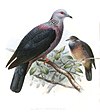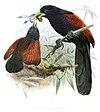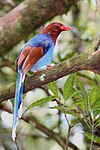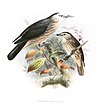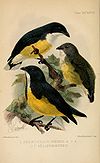List of endemic birds of Sri Lanka
| Part of a series on |
| Wildlife of Sri Lanka |
|---|
 |
Sri Lanka is home to 26 endemic bird species and seven proposed endemic species.[1] The total number of bird species recorded in the island is 492 of which 219 are breeding residents. BirdLife International recognize Sri Lanka as one of the world's Endemic Bird Areas (EBAs).[2] The number of endemic species has changed many times over the years.[3] This is largely due to "close taxonomic revisions". The number of endemic species has fluctuated from a minimum 20 to a maximum 47.[1] From 1977 the number settled at around 21. The figure was increased to 23 with the addition of two species in 1990. Many authorities have accepted this figure since then.[3] Wijesinghe published A checklist of the birds of Sri Lanka in 1994 which considered the addition of three more species, but this move did not receive widespread recognition because its rationale was not in keeping with rigorous taxonomic practice. Subsequent publications on the avifauna of Sri Lanka and the South Asia region have not listed these three as endemics. However, within some Sri Lankan circles considered the endemics proposed by Wijesinghe as acceptable. This may be due to an over-enthusiasm in increasing endemic numbers to create a better ornithological image and increase the demand for commercial birdwatching.[3]
In 2001, Warakagoda and Rasmussen described a new bird species, the Serendib scops-owl Otus thilohofmanni. This is the first new bird species discovered in Sri Lanka since 1868, when the Sri Lanka whistling-thrush (Myophonus blighi) was described.[4] There are some proposals for species level taxonomic revisions, and therefore endemic status in Sri Lanka.[1] The country prefix "Sri Lanka" in common names is normally restricted to endemic species. However Kotagama et al. (2006) disagree with Sibley and Monroe (1990) on the use of "Ceylon" in common species' names, suggesting instead that they should reflect the change of the official English name of the island from Ceylon to name Sri Lanka.[3] Sibley and Monroe's rationale was "Ceylon" is the geographical unit and "Sri Lanka" is the country which occupies the island. The geographical name is normally used for bird ranges, for example Madagascar is used rather than its nation, the Malagasy Republic."[3]
Change in number of endemics
| Year | Number of Species | Reference | Comment |
|---|---|---|---|
| 1872 | 37 | Holdsworth – Catalogue of Birds found in Ceylon | |
| 1880 | 47 | Legge – A history of birds of Ceylon | Included 17 species in the present list |
| 1931 | 25 | Wait – Manual of Birds of Ceylon | Excluded the red faced-malkoha |
| 1944 | 22 | Whistler – Avifaunal survey of Ceylon | |
| 1946 | 20 | Ripley – Comments to Endemic Birds of Ceylon | grey hornbill, rufous babbler and red- faced malkoha were excluded |
| 1952 | 21 | Phillips – Revised Checklist of Birds of Ceylon | red-faced malkoha and Ceylon grackle included |
| 1975 | 20 | Phillips – Revised Checklist of Birds of Ceylon | black capped bulbul excluded |
| 1977 | 21 | Flemming – Notes on endemic birds of Ceylon | rufous babbler included |
| 1978 | 21 | Phillips – Revised Checklist of Birds of Ceylon | |
| 1990 | 23+1 | Sibley & Monroe – Distribution and Taxonomy of Birds of the World | Crimson fronted barbet suggested as Endemic |
| 1994 | 23+1 | Kotagama and Fernando – A field guide to the Birds of Sri Lanka | Follow Sibley and Monroe |
| 1994 | 23+3 | Wijesinghe – A checklist of the birds of Sri Lanka | 3 species are suggested as Endemic |
| 1996 | 23+3 | Inskip et al. – An Annotated Checklist of the Birds of the Oriental Region | Follow Sibley and Monroe refers to Wijesinghe |
| 1998 | 23 | Grimmett et al. – Birds of the Indian Subcontinent | |
| 1999 | 23 | Harrison – A Field Guide to the Birds of Sri Lanka | |
| 2013 | 26 | Kotagama – A field guide to the Birds of Sri Lanka (revised) | Crimson-fronted barbet, Pompadour green pigeon and Black-capped bulbul included |
Source: Kotagama et al., 2013
Endemic species
Species which are validly published are considered as definitive endemic species.[1]
| Low Vulnerability | Threatened | |||||||||
|---|---|---|---|---|---|---|---|---|---|---|
|
|
| Common name | Binomial | Family | Habitat, Abundance, Distribution | Status |
|---|---|---|---|---|
| Order Galliformes | ||||
| Sri Lanka spurfowl | Galloperdix bicalcarata (Forster, 1781) |
Phasianidae | Humid forests. Common. All zones, except Northern region.[5] | |
| Sri Lanka junglefowl | Gallus lafayetii Lesson, 1831 |
Phasianidae | Forests, scrub jungles. Very common. All zones.[5] | |
| Order Columbiformes | ||||
| Sri Lanka wood-pigeon | Columba torringtoni (Blyth & Kelaart, 1853) |
Columbidae | Forests, gardens. Restricted range. Hill country. Descends to low country wet zone during fruiting seasons.[8] | |
| Sri Lanka green pigeon | Treron pompadora | Columbidae | ||
| Order Psittaciformes | ||||
| Sri Lanka hanging parrot | Loriculus beryllinus (Forster, 1781) |
Psittacidae | Forests, gardens. Common. All zones. More common in wet zone.[11] | |
| Sri Lanka emerald-collared parakeet | Psittacula calthropae (Blyth, 1849) |
Psittacidae | Forests, gardens. Common. Wet zone and some riparian forests dry zone.[11] | |
| Order Cuculiformes | ||||
| Sri Lanka red-faced malkoha | Phaenicophaeus pyrrhocephalus (Pennant, 1769) |
Cuculidae | Forests. Confined to undisturbed forest areas in the wet zone and riparian forests of the dry zone. Restricted location. All zones.[14] | |
| Sri Lanka green-billed coucal | Centropus chlororhynchos Blyth, 1849 |
Cuculidae | Undisturbed forests. Associated with bamboo and cane rushes. Restricted range. Low country wet zone and wet foothills.[16] | |
| Order Strigiformes | ||||
| Sri Lanka Serendib scops-owl | Otus thilohoffmanni Warakagoda & Rasmussen, 2004 |
Strigidae | Restricted range. Low country wet zone.[18] | |
| Sri Lanka chestnut-backed owlet | Glaucidium castanonotum (Blyth, 1846) |
Strigidae | Forests, scrubs, cultivations. Restricted range. Wet zone and hill country.[18] | |
| Order Bucerotiformes | ||||
| Sri Lanka grey hornbill | Ocyceros gingalensis (Shaw, 1811) |
Bucerotidae | Forests, gardens. Very common. All zones. Most plentiful in dry zone.[21] | |
| Order Piciformes | ||||
| Sri Lanka yellow-fronted barbet | Megalaima flavifrons (Cuvier, 1816) |
Megalaimidae | Forests, home gardens. Very common. More common in hill country.[21] | |
| Crimson-fronted barbet | Megalaima rubricapillus | Megalaimidae | ||
| Order Passeriformes | ||||
| Suborder Passeri: Songbirds | ||||
| Sri Lanka magpie | Urocissa ornata (Wagler, 1829) |
Corvidae | Undisturbed forests. Restricted range. Wet zone.[25] | |
| Black-capped bulbul | Pycnonotus melanicterus | Pycnonotidae | ||
| Sri Lanka yellow-eared bulbul | Pycnonotus penicillatus Blyth, 1851 |
Pycnonotidae | Forests, gardens close to forest, Common. Hill country.[28] | |
| Sri Lanka bush-warbler | Bradypterus palliseri (Blyth, 1851) |
Sylviidae | Forest undergrowth. Restricted range. Hill country.[30] | |
| Sri Lanka brown-capped babbler | Pellorneum fuscocapillus (Blyth, 1849) |
Timaliidae | Forests, scrub jungles. Ground level. Common. All zones.[32] | |
| Sri Lanka scimitar-babbler | Pomatorhinus melanurus Blyth, 1847 |
Timaliidae | Forests understory. Common. All zones.[32] | |
| Sri Lanka orange-billed babbler | Turdoides rufescens (Blyth, 1847) |
Timaliidae | Forests. Common. Wet zone. Less in hill country.[32] | |
| Sri Lanka ashy-headed laughingthrush | Garrulax cinereifrons Blyth, 1851 |
Timaliidae | Forests, mainly in understory and on the ground. Common. Wet zone. More in low country.[32] | |
| Sri Lanka white-eye | Zosterops ceylonensis Holdsworth, 1872 |
Zosteropidae | Forests, gardens, cultivations. Very common. Hill country.[37] | |
| Sri Lanka myna | Gracula ptilogenys Blyth, 1846 |
Sturnidae | Forests. Common. Wet zone. More common in Low country.[39] | |
| Sri Lanka white-faced starling | Sturnus albofrontatus (Layard, 1854) |
Sturnidae | Forests. Restricted range. Wet zone. Less in hill country.[39] | |
| Sri Lanka whistling-thrush | Myophonus blighi (Holdsworth, 1872) |
Turdidae | Undisturbed montane forests, streams. Restricted range. Hill country.[42] | |
| Sri Lanka spot-winged thrush | Zoothera spiloptera (Blyth, 1847) |
Turdidae | Humid forest undergrowth. Common. All zones. More common in wet zone.[42] | |
| Sri Lanka scaly thrush | Zoothera imbricata Layard, 1854 |
Turdidae | Forests undergrowth. Common. Hill country, some locations in low country wet zone.[42] | |
| Sri Lanka dull-blue flycatcher | Eumyias sordida (Walden, 1870) |
Muscicapidae | Forests, home gardens, well-wooded ravines. Hill country. Also in humid locations in the Low country wet zone.[46] | |
| Sri Lanka white-throated flowerpecker | Dicaeum vincens (Sclater, 1872) |
Dicaeidae | Forests. Common. Low country wet zone and lower hill country.[37] | |
Source: Kotagama, 2013
Proposed endemics
Rasmussen and Anderton (2005) proposed a number of species splits. Those that would create new endemic species for Sri Lanka are listed below along with their present taxon.[1]
| Current species | Binomial | Proposed splitting | Proposed binomial | Family | Status |
|---|---|---|---|---|---|
| Order Piciformes | |||||
| Greater flameback | Chrysocolaptes lucidus | Crimson-backed flameback | Chrysocolaptes stricklandi | Picidae | |
| Order Passeriformes | |||||
| Suborder Passeri: Songbirds | |||||
| Common woodshrike | Tephrodornis pondicerianus | Sri Lanka woodshrike | Tephrodornis affinis | Prionopidae | |
| Greater racket-tailed drongo | Dicrurus paradiseus | Sri Lanka crested drongo | Dicrurus lophorinus | Dicruridae | |
| Red-rumped swallow | Hirundo daurica | Sri Lanka swallow | Hirundo hyperythra | Hirundinidae | |
Source: Kaluthota and Kotagama, 2009
References
- ^ a b c d e Kaluthota, C. D.; Kotagama, S.W. (October 2009). "Revised Avifaunal List of Sri Lanka" (PDF). Occasional Paper No.02. Field Ornithology Group of Sri Lanka.
- ^ "BirdLife EBA Factsheet". BirdLife's online World Bird Database: the site for bird conservation. BirdLife International. 2003. Retrieved 2 July 2010.
- ^ a b c d e Kotagama, Sarath W.; De Silva, Rex I.; Wijayasinha, Athula S.; Abeygunawardane, Vathsala (2006). "Avifaunal List of Sri Lanka". In Bambaradeniya, C.N.B. (ed.). Fauna of Sri Lanka: Status of Taxonomy, Research and Conservation (PDF). The World Conservation Union, Colombo, Sri Lanka & Government of Sri Lanka. pp. 164–203. ISBN 955-8177-51-2.
- ^ Warakagoda, Deepal (January–February 2001). "Discovery of a new species of owl in Sri Lanka" (PDF). CBCN. Retrieved 2 July 2010.
- ^ a b Kotagama 2006: p. 44
- ^ Template:IUCN2010
- ^ Template:IUCN2010
- ^ Kotagama 2006: p. 62
- ^ Template:IUCN2010
- ^ Template:IUCN2010
- ^ a b Kotagama 2006: p. 54
- ^ Template:IUCN2010
- ^ Template:IUCN2010
- ^ Kotagama 2006: p. 52
- ^ Template:IUCN2010
- ^ Kotagama 2006: p. 50
- ^ Template:IUCN2010
- ^ a b Kotagama 2006: p. 58
- ^ Template:IUCN2010
- ^ Template:IUCN2010
- ^ a b Kotagama 2006: p. 48
- ^ Template:IUCN2010
- ^ Template:IUCN2010
- ^ Template:IUCN2010
- ^ Kotagama 2006: p. 72
- ^ Template:IUCN2010
- ^ Template:IUCN2010
- ^ Kotagama 2006: p. 82
- ^ Template:IUCN2010
- ^ Kotagama 2006: p. 84
- ^ Template:IUCN2010
- ^ a b c d Kotagama 2006: p. 90
- ^ Template:IUCN2010
- ^ Template:IUCN2010
- ^ Template:IUCN2010
- ^ Template:IUCN2010
- ^ a b Kotagama 2006: p. 88
- ^ Template:IUCN2010
- ^ a b Kotagama 2006: p. 80
- ^ Template:IUCN2010
- ^ Template:IUCN2010
- ^ a b c Kotagama 2006: p. 78
- ^ Template:IUCN2010
- ^ Template:IUCN2010
- ^ Template:IUCN2010
- ^ Kotagama 2006: p. 76
- ^ Template:IUCN2010
- ^ Template:IUCN2010
- ^ Template:IUCN2010
- ^ Template:IUCN2010
- ^ Template:IUCN2010
- ^ Template:IUCN2010
Literature cited
- Kotagama, Sarath (2006). Common, Endemic & Threatened Birds in Sri Lanka. Field Ornithology Group of Sri Lanka. p. 125. ISBN 955-8576-19-0.







